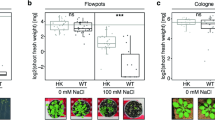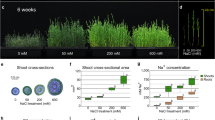Abstract
IT has been suggested that a possible role of boron in higher plants is to activate the processes involved in the uptake and movement of sugars, and the manner of operation has been attributed to the facility with which boric acid forms complexes with the cis-hydroxyl groups of the sugar molecule. Dugger and Humphrey1 suggest, as the result of assay of a comprehensive range of enzymes from pea seedlings, that boron inhibits sucrose synthesis from uridinetriphosphate, glucose-1-phosphate and fructose, and stabilizes the level of uridine diphospho-glucose as well as increasing the rate of its formation. They consider that boron inhibits starch phosphoryl-ase, thus increasing the availability of glucose-1-phosphate for the formation of uridine diphospho-glucose. The transfer of the former through the normal glycolytic cycle is considered to be unaffected on the basis of assay of specific enzymes, including phosphoglucomutase. The phosphoglucomutase used was apparently prepared from muscle, and, in fact, it has been shown that low concentrations of boric acid specifically inhibit the phosphoglucomutase of pea seeds2. The enzyme can be purified by alcohol fractionation at − 5° C. and obtained free of phos-phorylase and phosphatases which utilize the substrate and products. The phosphoglucomutase activity is always associated with that of phospho-hexoisomerase, but this enzyme has been found to be unaffected by boric acid. Fig. 1 shows the extent of the inhibition by a range of concentration in a preparation of this type. The fall in inorganic phosphorus + phosphorus released by hydrolysis at 100° C. in 1 N hydrochloric acid (free + 7′P) is used as a measure of formation of glucose-6-phosphate. When the purified system is used, no increase in inorganic phosphorus occurs during the time required for the system to reach equilibrium, and at this time chromatographic assay indicates the presence of only glucose-1-phosphate, glucose-6-phosphate and fructose-6-phosphate.
This is a preview of subscription content, access via your institution
Access options
Subscribe to this journal
Receive 51 print issues and online access
$199.00 per year
only $3.90 per issue
Buy this article
- Purchase on Springer Link
- Instant access to full article PDF
Prices may be subject to local taxes which are calculated during checkout
Similar content being viewed by others
References
Dugger, jun., W. M., and Humphrey, T. E., Plant Physiol., 35, 523 (1960).
Loughman, B. C., Ph.D. thesis, University of Cambridge (1953).
Author information
Authors and Affiliations
Rights and permissions
About this article
Cite this article
LOUGHMAN, B. Effect of Boric Acid on the Phosphoglucomutase of Pea Seeds. Nature 191, 1399–1400 (1961). https://doi.org/10.1038/1911399a0
Issue Date:
DOI: https://doi.org/10.1038/1911399a0
This article is cited by
-
Regulation of enzymatic activity
Biological Trace Element Research (1998)
-
Versuche mit Bor an Lemnaceen Die Wirkung des Bors auf den Kohlenhydratgehalt vonLemna minor L
Die Kulturpflanze (1962)
Comments
By submitting a comment you agree to abide by our Terms and Community Guidelines. If you find something abusive or that does not comply with our terms or guidelines please flag it as inappropriate.



